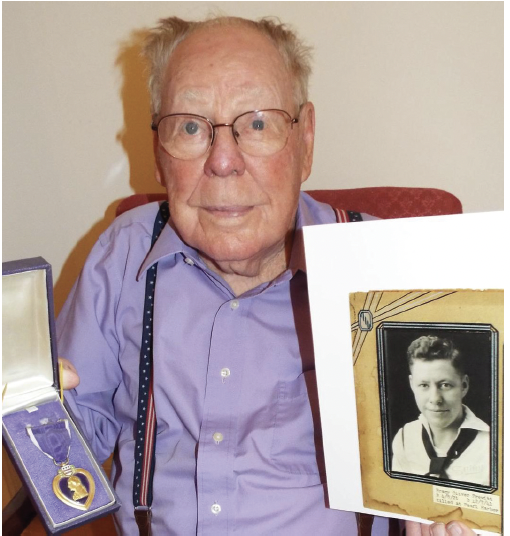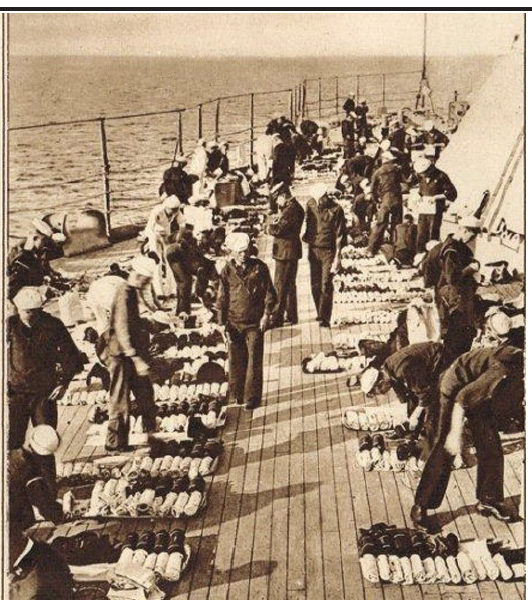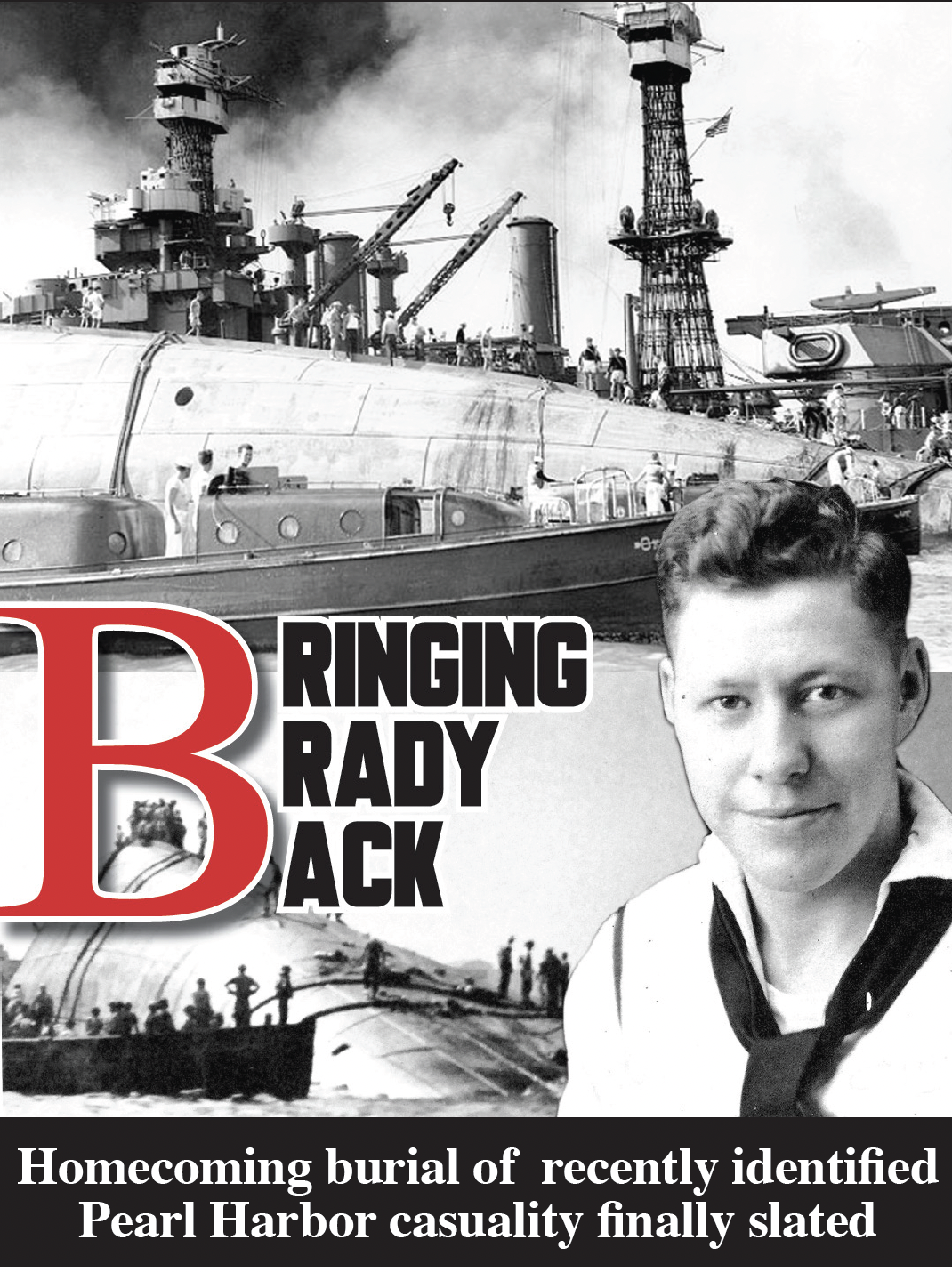Tammy Curtis, Managing Editor
The final journey home for a young sailor whose life was cut short over 80 years age was postponed due to the Covid-19 virus in 2019. Off the beaten path in rural Northern Sharp County sits a peaceful family cemetery, on the very land Seaman Second Class Brady Prewitt was born and will be buried. The final journey home for this brave young sailor, whose life was cut short over eight decades ago was first postponed in 2019 due to the Covid 19 Pandemic. Today, Friday, May 13, he made his way home. Next Wednesday, he will join generations of great veterans from his family, dating as far back as the Civil War in his final burial and eternal rest.
April 8, 2019 was supposed to be the final coming home party for the young man who would have been 99 years old the same day. Prewitt was due to be buried on what used to be the Prewitt family farm near Martin Creek on what is now the Perry Cemetery. His body was finally identified in August, 2018 through DNA after going down on the U.S.S. Oklahoma in Pearl Harbor, Hawaii on Dec. 7, 1941. Brady was supposed to be finally be brought home on May 17 this time, and given the military recognition he has deserved for so long before making his final voyage to his eternal resting place.
But, his journey from the airport in Little Rock happened a few days early. Around 11:45 p.m. May 13, Funeral Director Doug Wortham and Chloe Ward, with Wortham Funeral and Cremation in Highland, met Navy personnel and the plane carrying Prewitt’s remains. He was graciously escorted all the way back to Highland with all the pomp and circumstance fitting for such a brave young soul. Patriot Guard riders and others veteran bikers and police from several cities escorted the hearse to the funeral home, where it will remain until the grand finale, next week. He was met at the Funeral Home by veteran Wes Austin, quartermaster with the Highland VFW Post 4772.

Prewitt’s body is unloaded from the airplane covered in an American flag before being carried to Wortham Funeral Home’s hearse by representatives of the U.S. Navy on Friday, May 13, 2022, over 81 years after his death at Pearl Harbor.
A visitation will be held at the A.L. Hutson Memorial Center in Highland on Wed., April 18, from 11 a.m. to noon, with riders from the Patriot Guard and other veteran biker organizations following the funeral procession and escorting him to his final resting place on the very farmland in which he was raised.
Brady never lived to see his 21st birthday, he would never marry or have children, attend college or see his family again. The Hardy native’s body was one of the hundreds of service members remains who were interred, jumbled together, unidentifiable, just the way they went down that historical day.
From December 1941 to June 1944, Navy personnel recovered the remains of the deceased crew from the ship, including Brady’s. They were then interred in the Halawa and Nu’uanu Cemeteries in Hawaii.
Just over three years later, in September 1947, tasked with recovering and identifying fallen U.S. personnel in the Pacific Theater, members of the American Graves Registration Service (AGRS) disinterred the remains from the two cemeteries and transferred them to the Central Identification Laboratory at Schofield Barracks.
April 8, 2019 was supposed to be the final coming home party for the young man who would be 99 years old the same day. Prewitt was due to be buried on what used to be the Prewitt family farm near Martin Creek. His body was finally identified in August 2018 through DNA after going down on the U.S.S. Oklahoma in Pearl Harbor, Hawaii on Dec. 7, 1941
At that time, despite their painstakingly difficult work, the laboratory staff was only able to confirm the identifications of 35 men from the U.S.S. Oklahoma. The unidentified were again buried in 46 plots at the National Memorial Cemetery of the Pacific, known as the Punchbowl, in Honolulu. In October 1949, a military board classified those who could not be identified as non-recoverable.

The late Paul Prewitt of North Carolina, formerly of Hardy, shows a photo of his brother Brady, who was killed aboard the USS Oklahoma in Pearl Harbor on Dec. 7, 1941 holds his photo and the Purple Heart that was posthumously awarded to Brady. Brady will be buried near Hardy May 18 with full military honors.
For nearly three quarters of a century, the bodies lay commingled and unidentified. Their families wept for their loved ones but lacked the closure many received who were granted the benefit of bringing them home for proper burial in a location in which they could visit. Many second generation grandchildren are now realizing the hardship this placed on their grandparent’s families. For grandchildren, these deaths were often a topic that wasn’t discussed.
In 2003, as a result of research efforts of Pearl Harbor survivor Ray Emory, a single casket associated with the U.S.S Oklahoma was disinterred. Anthropological and DNA evidence proved that remains were combined with those of at least 95 individuals in the first disinterred casket. This is according to forensic anthropologist Dr. Carrie Brow of the Defense Prisoner of War Accounting Agency (DPAA).
Between June and November 2015, DPAA personnel exhumed the U.SS. Oklahoma Unknowns from the Punchbowl for analysis.
Things changed drastically when new DNA testing methods were made available. Prewitt’s family members submitted DNA that resulted in his identification. Brady’s body was due to be sent to Arkansas on his 99th birthday, but the Coronvirus scare and the travel and gathering ban prevented his 100 year old brother, Paul, from traveling from North Carolina for the funeral. Sadly, his brother, who was also an Army veteran, passed away in in 2021 at the age of 101 before seeing his brother bro thought home. At that time, the family instead opted to wait until Brady can be memorialized in the way he deserves. His next of kin, a nephew will attend the services. Regardless, the story is one that needs to be told and is one that many seem to have forgotten when looking into the eyes of the few World War II veterans in the area.
When Brady awoke to go about his normal daily activities that bright and balmy Dec. 7, 1941 morning, the young man was away from home for the first time in his 20 year old life. Like any other day aboard the U.S.S. Oklahoma, he undoubtedly ate his breakfast and had begun his chores the same as the hundreds of other sailors and Marines aboard the Navy ship. Brady was one of the lower ranked officers, as a seaman second class. He had just joined the military just over a year prior in June of 1940.

A routine bag inspection about the ship just weeks before the attacks in Nov. 1941. At the time of the photo, Prewitt would have been on board the ship.
The cleaning and other mundane chores the young sailors were completing were likely as routine as any other day. Around 6:30 a.m. the lives of everyone on board would be forever impacted and, sadly, the lives of 429 would end in a fiery death most would not wish on their worst enemies. Among them, was the young Hardy native.
At 6:30 a.m. A general quarters call on the nearby U.S.S. Ward informed the crew they thought they saw a periscope behind the ship. The skipper told the men to load all the guns and prepare. No alarm bells were set off. In the meantime, about 200 miles away on Japanese Aircraft carriers, the crews were cheering on 83 planes taking off from six carriers headed straight for Ford Island, Hawaii, where a fleet of eight American battleships sat anchored about 600 feet apart in the shallow waters of the harbor.
The Japanese Empire’s planes were picked up on radar about 136 miles out, and dismissed because the Navy was aware that there were B-17s coming from California. To them, the planes that would seal the fate of so many were dots on a screen. They were taken by surprise in an area in which they thought they were safe from torpedoes due to the shallow waters.
According to historical accounts from survivors, The U.S.S. Oklahoma capsized at 8:08 a.m., approximately 12 minutes after the first of as many as nine torpedoes struck. Hundreds of men were trapped below her decks. They undoubtedly found themselves in a terrifying world turned upside down, in pitch-black darkness, as compartments filled with water.
Survivor Seaman First Class Stuart Hedley recalled in an Arkansas Educational Television Network (AETN) documentary on the battle that it felt as if the massive ship was “jumping out of the water.” This sent the crew quickly below the deck. Hedley said he could actually see a Japanese pilot laughing as he passed by at around 30 feet above the water and even heard the pilot scream at them before dropping the torpedo.
The men ran to their battle stations and those below deck lost track of the hits. Men were frantically trying to escape from below deck as the Pacific water rushed in. Hedley explained the first instinct of a sailor is to seal off the ship, “When I got in the handling room, someone had spilled some oil on the steel deck down there and they are all jabbering as they were slipping and couldn’t get up due to the angle.” Once he got to the radio room, Hedley, recalled a shell coming through the turret. “Everyone had to make a direct contact with life and death,” he explained.
Signalman First Class Paul Goodyear, 100, who was instrumental in the campaign to identify survivors was only 21 that fateful morning as he served along side Prewitt. He recalled the first bomb didn’t bother them, they were along Ford Island and felt safe, but he quickly learned it wasn’t a drill when he saw the torpedo planes approaching. At the time, the crew was prepared for an inspection and all ammunition was stored away from the guns when the attack ensued.
First two, then three, then four torpedoes hit the Oklahoma as crews rushed for their battle stations. Goodyear recalls his 36 inch telescope started sliding as the ship took on hits and began to roll over and capsize. He saw the bomb that destroyed the U.S.S. Arizona. “I didn’t wait to see the explosion, I was looking for a way to jump in the water and swim to U.S.S. Maryland.” Goodyear climbed off as the ship was about half way over. He recalled being about 50 feet above the water when he stepped off and dropped into the fiery hot water, swimming to the safety of the nearby U.S.S. Maryland. With both arms, he took a hold of a rope and was pulled up. As he was being saved, he recalled seeing paint being chipped off the Maryland – realizing he was being shot at as he was being rescued. The next hours seemed like years to survivors as they watched only 32 more men be cut from the ship, while another 429, including Prewitt, died inside the watery grave of the Oklahoma.
”We knew there was no way in hell those kids would get out of there, too many nights I laid there and look at that and what must have been going through their head was just short of their last breath, it was pitch black down there,” Goodyear said of watching the rescue and recalling it for the documentary. Even survivors felt guilt that although it didn’t kill them, the pain of seeing their brothers die in such a way was unbearable. It did, however, revive their will to fight back in a way like never before.
In 1943 the Oklahoma was re-floated and Goodyear was given opportunity to search for his possessions. “I put my right foot over the hatch, and as I did, I was carrying a torch and it swept across the floor, the deck was covered with bones, you couldn’t recognize anything in there,” he sadly recalls.
A year after his brother, Brady was killed, Paul Prewitt, who turned 100 March 23, was drafted into the Army and was working in Washington. He recalled getting the news. His parents received a telegram, first telling them Brady was missing, and later that he was killed on the ship and couldn’t be identified for burial. They told them their son’s remains would buried in the unknown grave.
The Prewitt brothers enjoyed many childhood memories in the foothills of the Ozarks near Martin Creek on a farm that belonged to their grandfather. It was where Brady was born, and will ultimately remain.
Paul last saw his younger brother in June of 1940 before he entered the Navy. Brady graduated from high school in Liberal, Mo. where he had moved to live with his mother during part of his high school years. He played football in high school and immediately joined the Navy after graduation.
The family moved to rural Hardy area in 1920 and lived on the large farm. In 1928, they moved to town in Hardy, before later moving to Colorado. Paul recalled living on the “river side of the highway” at Hardy. He said. “At that time, there was nothing there but the courthouse and an old house, no stores or anything.” It was his own grandfather who donated land for the cemetery. For many years, it was called the Prewitt Cemetery, but is currently the Perry Cemetery. He knew many of those whose land joined theirs but said they are all gone now.
The story of how Brady’s DNA was obtained is also unusual. A cousin on Brady’s mother’s side gave a blood sample a few years ago after attempts to persuade Paul a few years prior failed. Last fall, he received three calls. He at first thought they were a scam. The last call was to inform him they had identified Brady’s remains.
Paul didn’t actually believe the caller and first told her he wasn’t interested. She continued to call and wanted to come from Memphis, to North Carolina where he lived. Because they didn’t know who she was, both he and his caregiver were very skeptical. She then offered to send her identification information to the family. They decided since she wasn’t asking for anything, they would meet with her. Due to the fact they had a trip planned to Hardy, which is much closer to Memphis for the woman, they agreed to meet in Hardy. “Commander Colleen Lowe with the U.S. Navy walked into McDonald’s in Hardy in full Navy uniform. We had a wonderful visit. She brought some information they gathered about Brady and we planned the burial,” his caregiver explained.
His legs, left arm and skull were exhumed and identified through mitochondrial DNA. The family explained if any more remains are identified prior to his burial, they will include them.
Brady’s body was set to arrive April 8, 2019 in Little Rock from the U.S. Navy. The Patriot Guard Riders were going to escort the body with Wortham Funeral Home to the graveside near Martin Creek. Paul and his caregiver had planned to make the drive from North Carolina due to the virus and Paul’s age, they opted to postpone the burial.

Photo/ Chloe Ward
Funeral Director Doug Wortham reverently watches as Naval officers load the remains of Seaman Second Class Brady Prewitt into the hearse on May 13 for his final ride back to Hardy, Arkansas, where he grew up. His memorial service will be held at the A.L. Hutson Center on Wed. May 18 from 11 a.m until noon. Burial will be with his family at the Perry Cemetery at Martin Creek.
Perhaps best eulogizing his life and untimely death is that of one of his shipmates, survivor Stephen Bower Young, “Despite the passage of time, it seems like yesterday. My mind sees clearly the shipmates I knew so well as they emerged, laughing and talking from a hatch, port-side, main deck, aft, of the Oklahoma. It is a time for morning quarters for muster, and at the urging of their petty officers, the white-uniformed sailors good-naturedly form into double ranks. They stand at ease, squaring round hats over suntanned faces. Their talk is animated and they turn in my direction. Then a cloud grows darker and I see those certain few less clearly.”
Brady’s body will be covered with the full Navy uniform with his Purple Heart pinned on its rightful place above his heart. He will buried with full military honors at the Perry Cemetery in Northern Sharp County near Martin Creek.

